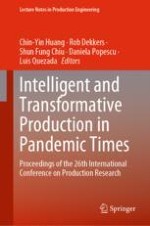This book contains the proceeding of the 26th International Conference on Production Research (ICPR). ICPR is a biennial conference that has been hosted for more than a half century. It is regarded worldwide as one of the leading conferences of production research, industrial engineering, and related subjects.
The acute impact of the pandemic on human lives is spurring further research and advances: because modern life relies on production and supply networks. The future of production calls for transformative research exploiting the possibilities of artificial intelligence in particular to respond to the challenge of sustainability.
This book is of interest to researchers, students, and professionals in industry.
